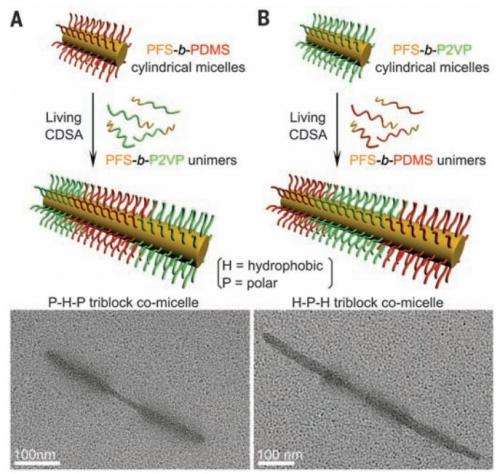March 20, 2015 report
Researchers find a way to build supermicelles from simple polymers

(Phys.org)—A team of researchers working at the University of Bristol in the U.K. has found a way to build supermicelles from simple polymers. In their paper published in the journal Science, the team describes their 3-step process and the types of supermicells they were able to build. In-Hwan Lee, Suyong Shin and Tae-Lim Choi with Seoul National University in South Korea offer a Perspective piece describing the work done by the team and their results, in the same journal issue
One of the goals of synthetic chemists is to build large complicated molecules from reagents—in this new effort the researchers have built on prior research to build longer length micelles (a combined group of cells in a colloidal solution). As Lee, Shin and Choi note, the process can be compared to using single Lego blocks to build much larger and complicated structures.
To build larger molecules, chemists have developed techniques for causing smaller molecules to connect together automatically, either lengthwise, to form long chains, or as groupings that form spheres, cylinders, etc., generally by putting them in a solvent where one part of the group is soluble and the other is not. While the process works, chemists find it difficult to control the size and/or shape of the resultant molecule. Recent work has shown that crystallization-driven self assembly offers a more controllable outcome. The work by this new team builds on that of the others.
To cause their supermicelles to come about via self assembly, the team first prepared narrow-disperse block copolymers causing cylindrical micelles to grow. In the second step, the researchers prepared amphiphilic triblock comicelles to help control growth length. In the final step, the researchers caused supermicellization to come about using selective solvents. The resulting molecules were shown able to persist in both a solution and solid state. The researchers suggest such molecules could find uses in optoelectronics, sensing or perhaps biomedicine.
Using their technique the researchers were able to create supermicelles in a variety of shapes (from those with loops to those with one or three dimensional lattices) and sizes (on the order of micrometers) demonstrating a new milestone in control over the complexity of superstructures. Lee, Shin and Choi suggest that future efforts might seek to further control the size and shape of the supermicelles or to find a way to make the process move along faster.
More information: Multidimensional hierarchical self-assembly of amphiphilic cylindrical block comicelles, Science 20 March 2015: Vol. 347 no. 6228 pp. 1329-1332. DOI: 10.1126/science.1261816
ABSTRACT
Self-assembly of molecular and block copolymer amphiphiles represents a well-established route to micelles with a wide variety of shapes and gel-like phases. We demonstrate an analogous process, but on a longer length scale, in which amphiphilic P-H-P and H-P-H cylindrical triblock comicelles with hydrophobic (H) or polar (P) segments that are monodisperse in length are able to self-assemble side by side or end to end in nonsolvents for the central or terminal segments, respectively. This allows the formation of cylindrical supermicelles and one-dimensional (1D) or 3D superstructures that persist in both solution and the solid state. These assemblies possess multiple levels of structural hierarchy in combination with existence on a multimicrometer-length scale, features that are generally only found in natural materials.
Journal information: Science
© 2015 Phys.org




















